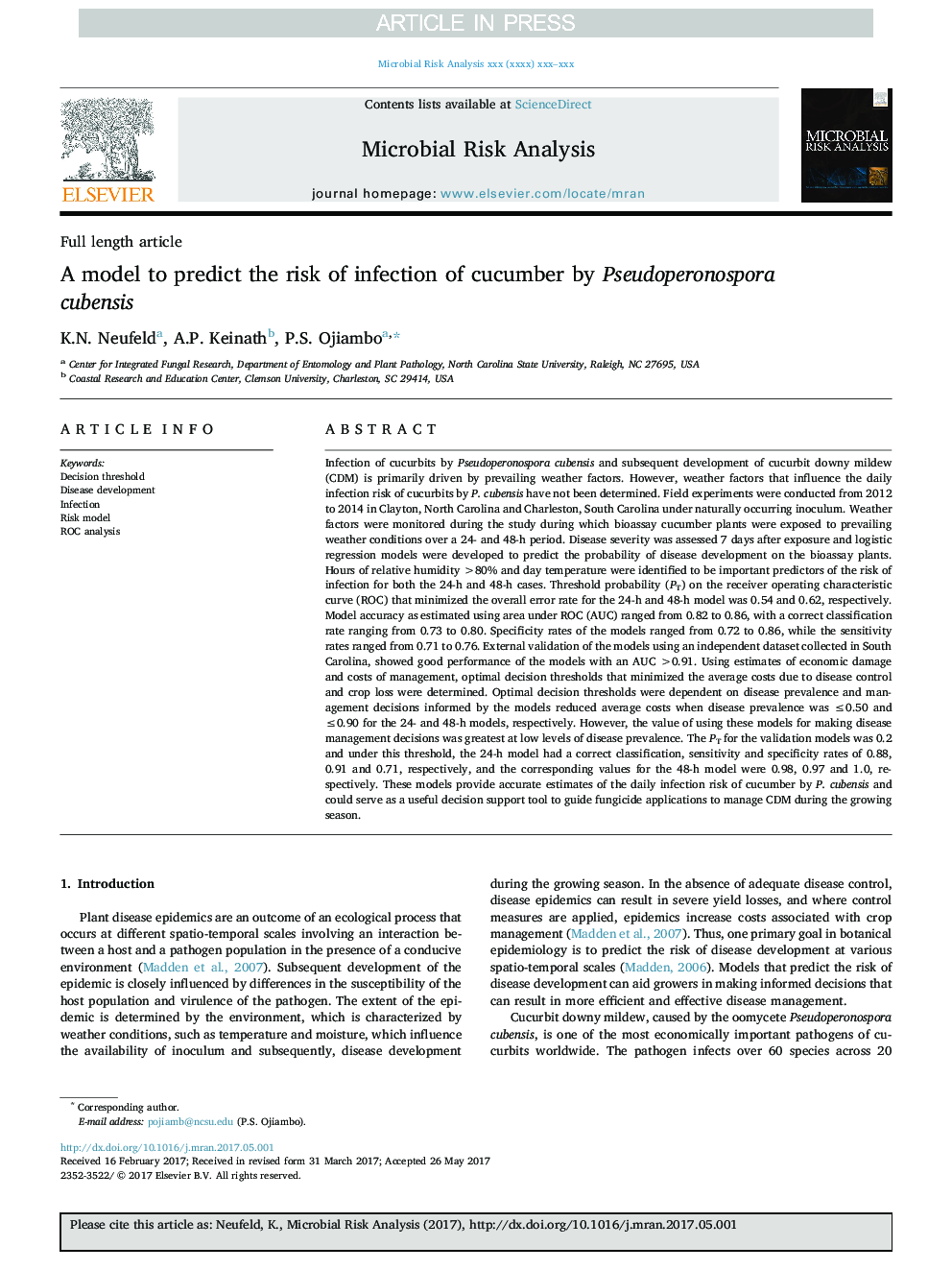| کد مقاله | کد نشریه | سال انتشار | مقاله انگلیسی | نسخه تمام متن |
|---|---|---|---|---|
| 5739668 | 1615862 | 2017 | 10 صفحه PDF | دانلود رایگان |
عنوان انگلیسی مقاله ISI
A model to predict the risk of infection of cucumber by Pseudoperonospora cubensis
دانلود مقاله + سفارش ترجمه
دانلود مقاله ISI انگلیسی
رایگان برای ایرانیان
کلمات کلیدی
موضوعات مرتبط
علوم زیستی و بیوفناوری
ایمنی شناسی و میکروب شناسی
میکروبیولوژی و بیوتکنولوژی کاربردی
پیش نمایش صفحه اول مقاله

چکیده انگلیسی
Infection of cucurbits by Pseudoperonospora cubensis and subsequent development of cucurbit downy mildew (CDM) is primarily driven by prevailing weather factors. However, weather factors that influence the daily infection risk of cucurbits by P. cubensis have not been determined. Field experiments were conducted from 2012 to 2014 in Clayton, North Carolina and Charleston, South Carolina under naturally occurring inoculum. Weather factors were monitored during the study during which bioassay cucumber plants were exposed to prevailing weather conditions over a 24- and 48-h period. Disease severity was assessed 7 days after exposure and logistic regression models were developed to predict the probability of disease development on the bioassay plants. Hours of relative humidity >80% and day temperature were identified to be important predictors of the risk of infection for both the 24-h and 48-h cases. Threshold probability (PT) on the receiver operating characteristic curve (ROC) that minimized the overall error rate for the 24-h and 48-h model was 0.54 and 0.62, respectively. Model accuracy as estimated using area under ROC (AUC) ranged from 0.82 to 0.86, with a correct classification rate ranging from 0.73 to 0.80. Specificity rates of the models ranged from 0.72 to 0.86, while the sensitivity rates ranged from 0.71 to 0.76. External validation of the models using an independent dataset collected in South Carolina, showed good performance of the models with an AUC >0.91. Using estimates of economic damage and costs of management, optimal decision thresholds that minimized the average costs due to disease control and crop loss were determined. Optimal decision thresholds were dependent on disease prevalence and management decisions informed by the models reduced average costs when disease prevalence was â¤0.50 and â¤0.90 for the 24- and 48-h models, respectively. However, the value of using these models for making disease management decisions was greatest at low levels of disease prevalence. The PT for the validation models was 0.2 and under this threshold, the 24-h model had a correct classification, sensitivity and specificity rates of 0.88, 0.91 and 0.71, respectively, and the corresponding values for the 48-h model were 0.98, 0.97 and 1.0, respectively. These models provide accurate estimates of the daily infection risk of cucumber by P. cubensis and could serve as a useful decision support tool to guide fungicide applications to manage CDM during the growing season.
ناشر
Database: Elsevier - ScienceDirect (ساینس دایرکت)
Journal: Microbial Risk Analysis - Volume 6, August 2017, Pages 21-30
Journal: Microbial Risk Analysis - Volume 6, August 2017, Pages 21-30
نویسندگان
K.N. Neufeld, A.P. Keinath, P.S. Ojiambo,